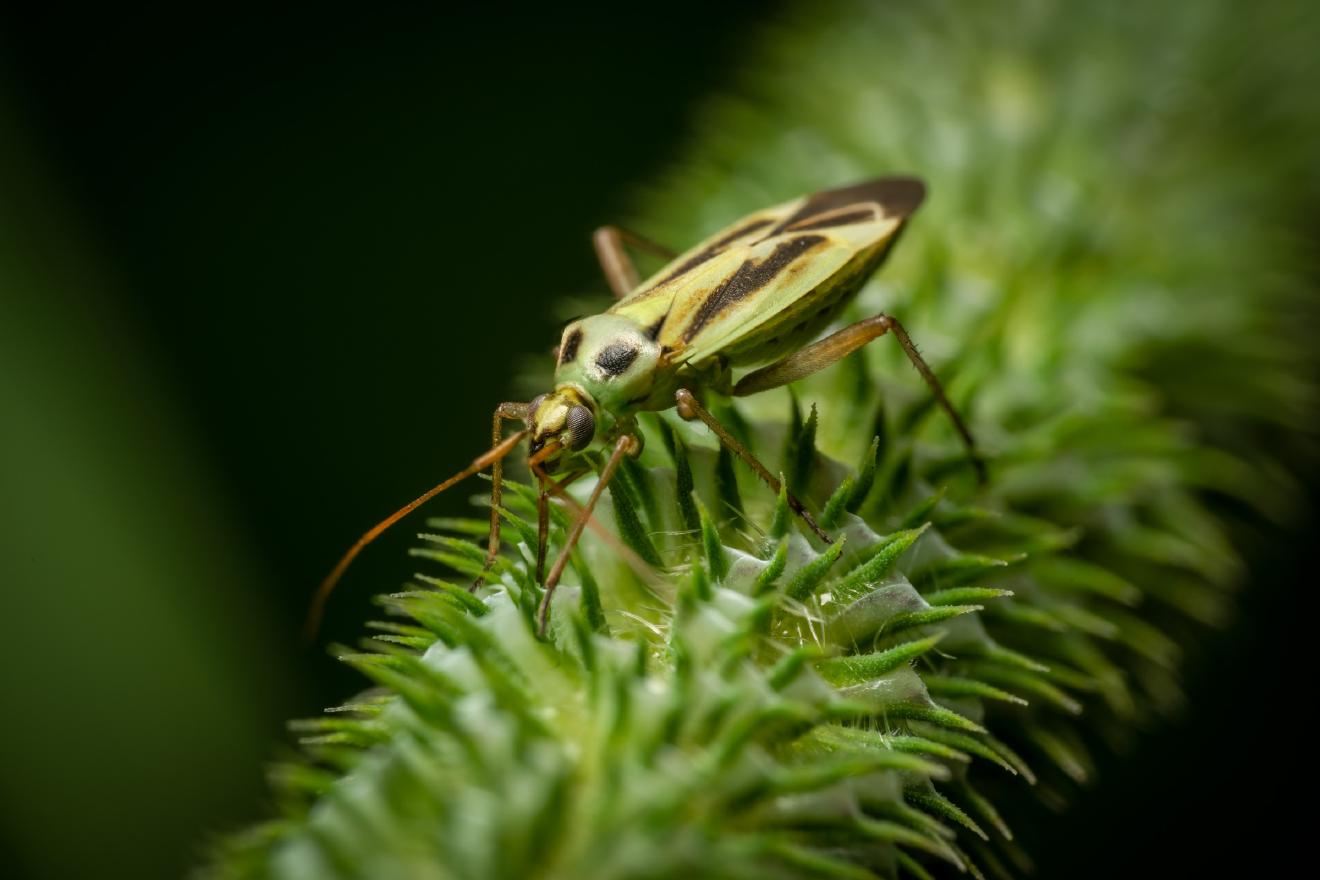The Stenotus binotatus is a large plant bug that can vary in appearance, with colors depending on sex and age. It is native to most of the Palearctic but has been introduced to temperate regions worldwide. The bug feeds on grasses, particularly timothy-grass, and has been found on a variety of plants in New Zealand. It produces enzymes that degrade gluten in the grasses it feeds on, causing damage to crops. The bug was described by Johan Christian Fabricius in 1794 and is known by several common names.


Description
#Stenotus binotatus is a fairly large plant bug (6–7 millimetres or 0.24–0.28 inches long), which is somewhat variable in appearance. The insect’s sides are roughly parallel, and the colours depend on both the animal’s sex and its age, the markings becoming darker and stronger with increasing age. Males are mostly yellow, with darker markings on the pronotum and forewings, which females are greenish-yellow with paler markings.
Distribution
#S. binotatus is native to most of the Palearctic but has been introduced to temperate regions around the world. It is common “throughout the northern and central U.S. and southern Canada”, and it has been introduced to New Zealand, where it is now found almost throughout the country.
Ecology
#Both the nymphs and adults feed on the inflorescences of grasses, especially timothy-grass (Phleum pratense). In New Zealand, S. binotatus has been collected from a large variety of plants, including the grasses brown top, Yorkshire fog, cocksfoot, wheat, barley and maize, and many other plants (including rushes, Hypericum, Leptospermum scoparium, Metrosideros, Nothofagus, Coriaria, Olearia, Muehlenbeckia, Carmichaelia, Larix decidua, Eucalyptus, Melicytus ramiflorus, Coprosma robusta, hemlock and nettles).Adults are active from June to September in the United Kingdom, and in December and January in New Zealand.
Crop damage
#Stenotus binotatus produces an enzyme which degrades the gluten in the grasses it feeds on. These enzymes are believed to be responsible for the characteristic “sticky dough” produced from wheat which has been attacked by plant bugs such as S. binotatus.The wheat grain does not show a pale area or puncture mark after attack by S. binotatus, in contrast to other bugs. Instead, the grains appear collapsed. Wheat grains from known bug infestation in New Zealand do not resemble those produced by S. binotatus, and SDS-PAGE patterns also suggest that S. binotatus was not the cause of infestations.
Taxonomic history
#Stenotus binotatus was originally described under the name Lygaeus binotatus by Johan Christian Fabricius in 1794. The genus Stenotus was erected by Wassily Ewgrafowitsch Jakowlew (also transcribed as “Jakovlev”) in 1877, and S. binotatus was designated its type species.S. binotatus is known by various common names, including two-spotted plant bug, timothy plant bug, and slender crop mirid.
External links
#Stenotus binotatus at Ecology of Commanster
The Stenotus binotatus is a large plant bug that can vary in appearance, with colors depending on sex and age. It is native to most of the Palearctic but has been introduced to temperate regions worldwide. The bug feeds on grasses, particularly timothy-grass, and has been found on a variety of plants in New Zealand. It produces enzymes that degrade gluten in the grasses it feeds on, causing damage to crops. The bug was described by Johan Christian Fabricius in 1794 and is known by several common names.
Ancestry Graph
%%{
init: {
'theme': 'base',
'themeVariables': {
'primaryColor': '#83a09c',
'primaryTextColor': '#212d2b',
'primaryBorderColor': '#fff',
'lineColor': '#fff',
'secondaryColor': '#006100',
'tertiaryColor': '#fff'
}
}
}%%
flowchart LR
classDef active fill:#fff
arthropods("phylum: Arthropods"):::active
arthropods-->insects("class: Insects"):::active
insects-->true-bugs("suborder: True Bugs"):::active
true-bugs-->plant-bugs("family: Plant Bugs"):::active
plant-bugs-.->alfalfa-plant-bug(["species: Alfalfa Plant Bug"])
plant-bugs-.->apolygus-lucorum(["species: Apolygus lucorum"])
plant-bugs-.->calocoris-affinis(["species: Calocoris affinis"])
plant-bugs-.->closterotomus-biclavatus(["species: Closterotomus biclavatus"])
plant-bugs-.->common-green-capsid(["species: Common Green Capsid"])
plant-bugs-.->common-nettle-flower-bug(["species: Common Nettle Flower Bug"])
plant-bugs-.->deraeocoris-lutescens(["species: Deraeocoris lutescens"])
plant-bugs-.->dicyphus-errans(["species: Dicyphus errans"])
plant-bugs-.->european-tarnished-plant-bug(["species: European Tarnished Plant Bug"])
plant-bugs-.->lygus-pratensis(["species: Lygus pratensis"])
plant-bugs-.->meadow-plant-bug(["species: Meadow Plant Bug"])
plant-bugs-.->orthotylus-nassatus(["species: Orthotylus nassatus"])
plant-bugs-.->psallus-varians(["species: Psallus varians"])
plant-bugs-.->red-spotted-plant-bug(["species: red-spotted plant bug"])
plant-bugs-.->spotted-plant-bug(["species: spotted plant bug"])
plant-bugs-.->three-spotted-nettle-bug(["species: Three Spotted Nettle Bug"])
plant-bugs-.->trigonotylus-ruficornis(["species: Trigonotylus ruficornis"])
plant-bugs==>two-spotted-grass-bug(["species: Two-spotted Grass Bug"]):::active
click alfalfa-plant-bug href "/en/catalogue/arthropods/insects/true-bugs/plant-bugs/alfalfa-plant-bug/"
click apolygus-lucorum href "/en/catalogue/arthropods/insects/true-bugs/plant-bugs/apolygus-lucorum/"
click calocoris-affinis href "/en/catalogue/arthropods/insects/true-bugs/plant-bugs/calocoris-affinis/"
click closterotomus-biclavatus href "/en/catalogue/arthropods/insects/true-bugs/plant-bugs/closterotomus-biclavatus/"
click common-green-capsid href "/en/catalogue/arthropods/insects/true-bugs/plant-bugs/common-green-capsid/"
click common-nettle-flower-bug href "/en/catalogue/arthropods/insects/true-bugs/plant-bugs/common-nettle-flower-bug/"
click deraeocoris-lutescens href "/en/catalogue/arthropods/insects/true-bugs/plant-bugs/deraeocoris-lutescens/"
click dicyphus-errans href "/en/catalogue/arthropods/insects/true-bugs/plant-bugs/dicyphus-errans/"
click european-tarnished-plant-bug href "/en/catalogue/arthropods/insects/true-bugs/plant-bugs/european-tarnished-plant-bug/"
click lygus-pratensis href "/en/catalogue/arthropods/insects/true-bugs/plant-bugs/lygus-pratensis/"
click meadow-plant-bug href "/en/catalogue/arthropods/insects/true-bugs/plant-bugs/meadow-plant-bug/"
click orthotylus-nassatus href "/en/catalogue/arthropods/insects/true-bugs/plant-bugs/orthotylus-nassatus/"
click psallus-varians href "/en/catalogue/arthropods/insects/true-bugs/plant-bugs/psallus-varians/"
click red-spotted-plant-bug href "/en/catalogue/arthropods/insects/true-bugs/plant-bugs/red-spotted-plant-bug/"
click spotted-plant-bug href "/en/catalogue/arthropods/insects/true-bugs/plant-bugs/spotted-plant-bug/"
click three-spotted-nettle-bug href "/en/catalogue/arthropods/insects/true-bugs/plant-bugs/three-spotted-nettle-bug/"
click trigonotylus-ruficornis href "/en/catalogue/arthropods/insects/true-bugs/plant-bugs/trigonotylus-ruficornis/"
click two-spotted-grass-bug href "/en/catalogue/arthropods/insects/true-bugs/plant-bugs/two-spotted-grass-bug/"
click arthropods href "/en/catalogue/arthropods/"
click insects href "/en/catalogue/arthropods/insects/"
click true-bugs href "/en/catalogue/arthropods/insects/true-bugs/"
click plant-bugs href "/en/catalogue/arthropods/insects/true-bugs/plant-bugs/"
Further Information
Copyright



